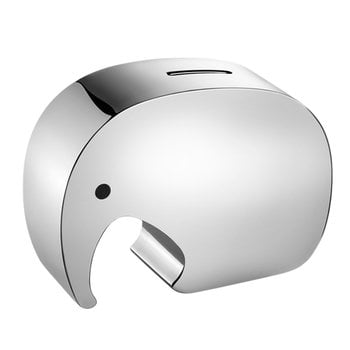Georg Jensen's Moneyphant was created by Jørgen Møller as well as his great-grand child. Møller's first elephant design, a bottle opener, was born in 1987 with the help of his grandchild. As the Elephant became recognized worldwide, Møller's then designed more elephants, such as a key ring and the Moneyphant for storing coins. The Moneyphant contains all that Scandinavian design has become known for: elegance, strength and functionality.
Moneyphant
Georg Jensen
Description
Georg Jensen's Moneyphant was created by Jørgen Møller as well as his great-grand child. Møller's first elephant design, a bottle opener, was born in 1987 with the help of his grandchild. As the Elephant became recognized worldwide, Møller's then designed more elephants, such as a key ring and the Moneyphant for storing coins. The Moneyphant contains all that Scandinavian design has become known for: elegance, strength and functionality.
Product details (4)
- Material
- Mirror polished stainless steel
- Width
- 6 cm
- Depth
- 17.3 cm
- Height
- 12.6 cm
- Product ID
Designer
Jørgen Møller (1930-2009) started his career by working in the drawing office of the Danish legend of architecture and design, Arne Jacobsen. Simple everyday objects have always interested Møller. Therefor he has designed several beloved everyday objects during his long career.
In 1987, Møller and his grandchild designed together the Elephant bottle opener, which became a global favorite. The bottle opener was followed by a money box and other products. Møller said that the will never stop designing: ”the world is open and I focus on many things and I constantly draw, so if someone asks my what was my best design, I always reply: the next one!”
View all productsReviews (0)
Sustainability
The Product Sustainability Framework, our criteria of sustainable design, helps you find the most sustainable products in our selection. Read below which sustainability criteria this product has met.
Working conditions & labour 9/9
-
Equal opportunities for all employees
-
Commitment to UN Global Compact, fair compensation for all employees
-
Corporate responsibility requirements defined and communicated for suppliers
-
Systematic work for improved inclusion and well-being in the workplace
-
Transparent supply chain
-
Suppliers' compliance to a code of conduct ensured
-
Direct suppliers audited and certified
-
Compliance to the UN Guiding Principles on Business and Human Rights ensured in the supply chain
-
Support for community involvement in the supply chain
Eco-friendly production 6/9
-
Fair and resource-wise water-use in production
-
No incineration or landfilling of returned items
-
No use of endangered species as materials
-
No direct environmental emissions or waste (excl. GHGs) from production
-
Material-efficient and ecological packaging
-
No potentially harmful chemicals used in own production
-
The sustainability of direct suppliers' production is addressed and monitored
-
Production and material sourcing that respect biodiversity, animal rights, and natural ecosystems
-
Positive impact on nature’s well-being through operations that regenerate natural ecosystems
Climate impact 4/8
-
Company's direct greenhouse gas emissions identified and commitment to reduction
-
Product's carbon impact identified and commitment to reduction
-
Guidance on energy- and eco-efficient use of the product
-
Contribution to climate initiatives beyond the brand’s direct operations
-
Low-carbon or compensated transportation
-
Carbon footprint of the product calculated and goals set to reduce it
-
100 % renewable energy in own production and operations
-
Carbon neutral or carbon negative product
Sustainable materials 5/6
-
Sustainable and long-lasting material choices
-
No harmful or hazardous substances
-
Responsible raw material sourcing and production
-
Materials suited for circularity: monomaterials, recyclable finishings, renewable or recycled contents etc.
-
Ecological materials: natural, biodegradable, recyclable or recycled contents
-
Outstanding materials in terms of innovativeness, responsibility, sustainability and circularity: local production or sourcing, 100 % recycled content, C2C-certification etc.
Circular design 4/5
-
High aesthetic quality promoting long-term use of the product
-
Technically durable product design and material choices
-
Design for enduring life-long quality
-
Design and support for product maintenance, repair and upgradability
-
Innovative circular design solutions: circular service system, resale platform, remanufacturing, collection of used products, etc.




